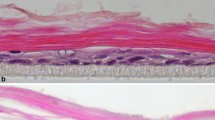Abstract
The signals for epidermal differentiation and barrier formation are largely unknown. One possible signal is dehydration or osmotic stress. To test this hypothesis, we investigated the effects of osmotic stress on markers of differentiation of normal human keratinocytes in culture. Hyperosmotic stress treatment of normal human keratinocyte cultures by elevated sorbitol concentrations was observed to induce markers of terminal differentiation. Sorbitol was added to keratinocyte media at 50, 100, 200, and 300 mM final concentration. These concentrations of sorbitol induce a dehydration effect or osmotic stress on the keratinocytes. These sorbitol treatments increased the levels of messenger RNA for the differentiation markers involucrin, transglutaminase, and filaggrin as measured by reverse transcription-polymerase chain reaction. Keratin K1 and K10 and involucrin protein levels were also increased in normal human keratinocyte cultures exposed to increasing osmotic stress. These observations suggest that keratinocytes in the epidermis may use dehydration as a sign to trigger the differentiation of the skin barrier.



Similar content being viewed by others
References
Aliaga, J. C.; Deschenes, C.; Beaulieu, J. F.; Calvo, E. L.; Rivard, N. Requirement of the MAP kinase cascade for cell cycle progression and differentiation of human intestinal cells. Am. J. Physiol. 277:G631–G641; 1999.
Batiza, A. F.; Schulz, T.; Masson, P. H. Yeast respond to hypotonic shock with a calcium pulse. J. Biol. Chem. 271:23357–23362; 1996.
Bernstam, L. I.; Vaughan, F. L.; Bernstein, I. A. Keratinocytes grown at the air–liquid interface. In Vitro Cell Dev. Biol. 22(12):695–705; 1986.
Dascalu, A.; Matithyou, A.; Oron, Y.; Korenstein, R. A. Hyperosmotic stimulus elevates intracellular calcium and inhibits proliferation of a human keratinocyte cell line. J. Invest. Dermatol. 115:714–718; 2000.
Dove, S. K.; Cooke, F. T.; Douglas, M. R.; Sayers, L. G.; Parker, P. J.; Michell, R. H. Osmotic stress activates phosphatidylinositol-3,5-bisphosphate synthesis. Nature 390:187–192; 1997.
Fernandez, E. Thymocyte development past the CD4(+)CD8(+) stage requires an active p38 mitogen-activated protein kinase. Blood 95:1356–1361; 2000.
Hennings, H.; Holbrook, K.; Steinert, P.; Yuspa, S. Growth and differentiation of mouse epidermal cells in culture: effects of extracellular calcium. Curr. Probl. Dermatol. 10:3–25; 1980.
Hollander, D. A.; Hakimi, M. Y.; Hartmann, A.; Wilhelm, K.; Windolf, J. The influence of hyperbaric oxygenation (HBO) on proliferation and differentiation on human keratinocyte culture. In Vitro Cell Dev. Biol. 1:261–269; 2000.
Kopan, R.; Traska, G.; Fuchs, E. Retinoids as important regulators of terminal differentiation: examining keratin expression in individual epidermal cells at various stages of keratinization. J. Cell Biol. 105:427–440; 1987.
Mak, V.H.; Cumpstone, M. B.; Kennedy, A. H.; Harmon, C. S.; Guy, R. H.; Potts, R. O. Barrier function of human keratinocytes cultures grown at the air–liquid interface. J. Invest. Dermatol. 96:323–327; 1991.
Paul, A.; Wilson, S.; Belham, C. M.; Roninson, C. J. M.; Scott P. H.; Gould, G. W.; Plevin, R. Stress-activated protein kinases: activation, regulation and function. Cell Signal. 9:403–410; 1997.
Pfundt, R.; Wingens, M.; Bergers, M.; Zweers, M.; Frenken, M.; Schalkwijk, J. TNF-alpha and serum induce SKALP/elafin gene expression in human keratinocytes by a p38 MAP kinase-dependent pathway. Arch. Dermatol. Res. 292:180–187; 2000.
Ponec, M.; Weerheim, A.; Kempenaar, J.; Boonstra, J. Proliferation and differentiation of human squamous carcinoma cell lines and normal keratinocytes: effects of epidermal growth, retinoids, and hydrocortisone. In Vitro Cell Dev. Biol. 24:764–770; 1988.
Prunieras, M.; Regnier, M.; Woodley, D. Methods for cultivation of keratinocytes with an air–liquid interface. J. Invest. Dermatol. 81:28s–33s; 1983.
Schlichter. L. C. Sakellaropoulos G intracellular Ca2+ signaling induced by osmotic shock in human T lymphocytes. Exp. Cell Res. 215(1):211–222; 1994.
Schliess, F.; Wiese, S.; Haussinger, D. Osmotic regulation of the heat shock response in H4IIE rat hepatoma cells. FASEB J. 13:1557–1564; 1999.
Takahashi, K.; Isobe, M.; Muto, S. An increase in cytosolic calcium ion concentration precedes hypoosmotic shock-induced activation of protein kinases in tobacco suspension culture cells. FEBS Lett. 401:202–206; 1997.
Tilly, B. C.; Gaestel, M.; Engel, K.; Edixhoven, M. J.; de Jonge, H. R. Hypo-osmotic cell swelling activates the p38 MAP kinase signalling cascade. FEBS Lett. 395:133–136; 1996.
Tilly, B. C.; Gatsios, P.; Ludwig, S.; Rapp, U. R.; Haussinger, D.; Heinrich, P.C.; Graeve, L. The mitogen-activated protein (MAP) kinase p38 and its upstream activator MAP kinase kinase 6 are involved in the activation of signal transducer and activator of transcription by hyperosmolarity. J. Biol. Chem. 274:30222–30227; 1999.
Williams, M. L.; Brown, B. E.; Monger, D. J.; Grayson, S.; Elias, P. M. Lipid content and metabolism of human keratinocyte cultures grown at the air-medium interface. J. Cell Physiol. 136:103–110; 1988.
Wu, Z.; Woodring, P. J.; Bhakta, K. S.; Tamura, K.; Wen, F.; Feramisco, J. R.; Karin, M.; Wang, J. Y.; Puri, P. L. p38 and extracellular signal-regulated kinases regulate the myogenic program at multiple steps. Mol. Cell Biol. 20:3951–3964; 2000.
Yoon, Y. M.; Oh, C. D.; Kim, D. Y.; Lee, Y. S.; Park, J. W.; Huh, T. L.; Kang, S. S.; Chun, J. S. Epidermal growth factor negatively regulates chondrogenesis of mesenchymal cells by modulating the protein kinase C-alpha, Erk-1, and p38 MAPK signaling pathways. J. Biol. Chem. 275:12353–12359; 2000.
Author information
Authors and Affiliations
Corresponding author
Additional information
Editor: J. Denry Sato
Rights and permissions
About this article
Cite this article
Mammone, T., Ingrassia, M. & Goyarts, E. Osmotic stress induces terminal differentiation in cultured normal human epidermal keratinocytes. In Vitro Cell.Dev.Biol.-Animal 44, 135–139 (2008). https://doi.org/10.1007/s11626-008-9087-z
Received:
Accepted:
Published:
Issue Date:
DOI: https://doi.org/10.1007/s11626-008-9087-z




